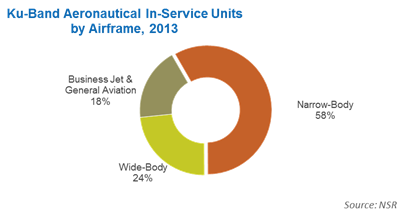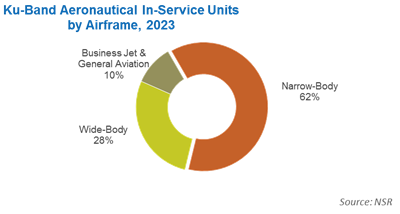The Sweet Spot for Ku-band IFEC
Jul 23rd, 2014
As airframe manufacturers keep raising their
20-year global aircraft demand forecast, sifting through the
expectations of which region and what type of aircraft will be
the sweet spot of connectivity is becoming a tricky endeavor.
But looking at manufacturer forecasts, single
aisle passenger jets such as the NG737 and the A320NEO (New
Engine Option) are the fastest growing segment over the next two
decades with Boeing pegging these at 25,700 new units in the
160-seat range. Asia is gaining the most interest for both
Boeing and Airbus as many carriers are buying them by the dozen.
The recent purchase of 50 B737s by China’s 9 Air, Spring
Airlines’ expected order of 30 A320NEOs, or Indonesia’s Lion
Air’s massive order of 234 Airbus A320s and A319s show the pace
of growth in the region. One simply hopes that
overcapacity from these carriers or higher oil prices in the
short-term will not mean cancellations.
Fortunately, Boeing and Airbus orders for
narrow-body units come mostly from North America and Europe
where the busiest short- and medium-haul traffic occurs. It is
also where the market for connectivity has already taken off
with over 680 planes already connected. These planes are
mostly for travel routes below 3 hours, but as airlines extend
their range to leverage their international presence in the face
of stiff competition from low-cost carriers, they are becoming
part of a complete offering whereby connectivity on all routes
and airframes is a major differentiator. Some airlines
such as United Continental and Delta Airlines have contracts in
place to outfit both long-range and regional aircraft with
satellite-based connectivity to do just that.

Already Row44 (Global Eagle) leads Ku-band
satellite-based connectivity in terms of in-service units thanks
to its installs on B737s owned by Southwest Airlines and
Norwegian, which also ordered 100 A320s recently. Row44,
GoGo and Panasonic also won orders from UTair, Icelandair,
AeroMexico, United Continental and WestJet to outfit what NSR
estimates is a backlog of more than 700 narrow-body Ku-band
connectivity units in the next 12 to 24 months. As a result, NSR
expects retail revenues from Ku-band units to overtake satcom
equipment revenues sometime in 2016 as ARPUs grow with the
larger installed base.

Bottom Line
Demand for connectivity does not stop at checking
emails or surfing the web, but it is also for delivery of TV,
movies and other content streamed to personal electronic devices
or backseat screens. And to serve content that is
increasingly bandwidth-hungry, Ku-band units are doing the job
(for now). Eventually, the advent of HTS capacity over North
America, the Atlantic Ocean and Europe will displace some VSAT
units on narrow-body aircraft away from Ku-band as more deals
are executed by the likes of ViaSat and Panasonic.
But as revenues from customers of satcom show, and
with more than 700 planes expected to be outfitted by the end of
2016, the sweet spot for Ku-band satellite-based in-flight
connectivity today is narrow-body aircraft in North America and
Europe, and eventually across the rest of the world.